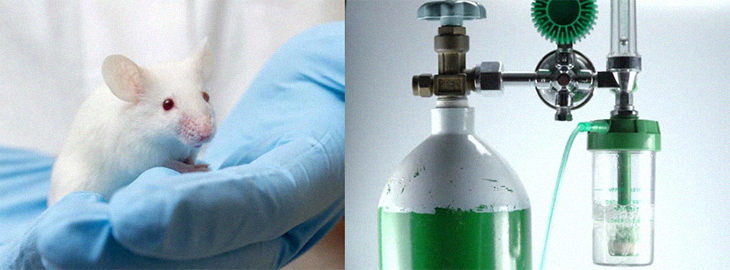New Study With Mice And Pigs Finds That There’s A Chance Humans Can Breathe Through Their Intestines

A new study has proven that pigs and rodents can actually breathe through their intestines. It may sound crazy, but these days, living on the moon has become an actual reality in the near future, so it seems nothing is impossible anymore. Of course the science behind this research is much more complicated than it might sound.
What researchers have found is that pigs and rodents can use their intestines for respiration by sending oxygen gas or oxygenated liquid up and through the animals’ anus and rectum. And through their experiment, the researchers managed to reverse respiratory failure symptoms in pigs and mice.
Initially, what these findings could mean is a chance to develop new emergency treatments that can possibly move towards helping people that are critically ill during times when mechanical ventilation is absent or unsuitable for use at the time of emergency. The research team aims to go further with their findings and attempt to do clinical trials on humans using this same research.
Senior study author, Dr. Takanori Takebe, who happens to work at the Tokyo Medical and Dental University and the Cincinnati Children’s Hospital Medical Center explained, “Artificial respiratory support plays a vital role in the clinical management of respiratory failure due to severe illnesses as pneumonia or acute respiratory distress syndrome.”
Dr. Takebe goes on, “Although the side effects and safety need to be thoroughly evaluated in humans, our approach may offer a new paradigm to support critically ill patients with respiratory failure.”
To learn more about the study, you can read the published article in the Med journal.
Intestinal Breathing in the Animal Kingdom
For certain aquatic organisms, their bodies have learned to adapt and survive in low oxygen environments. They’ve managed to evolve to having alternative breathing mechanisms, hand in hand with their gills or lungs. Particular examples of this are sea cucumbers, loaches, stretch spiders, and even freshwater catfish, which are all specimens that use their lower intestines for respiration. But no one knew whether mammals had the same capabilities, until now.
Dr. Takebe explained to publication Medical News Today (MNT), “This is [the] first [study] to our knowledge to show successful repurposing of the distal gut for breathing apparatus inspired by aquatic organisms. We are all surprised that [the] intestinal breathing capacity that the laches have is maintained even in mammalian species such that [it] is sufficient for rescuing [from] lethal hypoxia / asphyxia condition[s].”
How Does the Respiratory Rescue Work?
Dr. Takebe and his group chose rodent and pig animals to ‘provide evidence of intestinal breathing in mammals.’
Initially, they created an intestinal gas ventilation system that had the ability to transfer pure oxygen gas into the rectum of their mice subjects in a procedure that was basically like an enema.
After which, the team put the mice in oxygen conditions that were considered extremely low. If the rodents were not using the intestinal ventilation system, they wouldn’t have survived for even 11 minutes. But when the team dispensed oxygen gas through the anus, the average amount of time that the mice could survive increased to 18 minutes.
Moreover, the research shows that their system was most effective when they made a small cut or abrasion in the intestinal mucous membrane. What this did was allow ‘for more efficient movement of gas between the intestine and surrounding blood vessels.’ Results showed that the mice that had intestinal abrasion and gas ventilation had a massive 75% survival for at least 50 minutes in what researchers claimed would be an otherwise lethal environment.
Liquid vs. Gas Ventilation System
Despite the obvious success of the intestinal gas ventilation system, because there is a need to damage the intestinal mucosa, it is less likely to work for clinical trials in humans, especially for patients that are critically ill.
Because of this, the research team managed to find another solution for human use. Rather than gas, they used oxygenated liquid called perflourodecalin (PFD) so that they wouldn’t have to cause any abrasions of the intestinal mucus layer.
PFD, which is part of the substance group perfluorochemicals, has numerous studies that prove its safety for human use. It also has a much higher absorption capacity for both oxygen and carbon dioxide. There are even previous clinical trials that have tested the use of perfluorochemicals as a blood substitute.
During the clinical trial on mice using intestinal liquid ventilation, researchers found that the mice test group managed to walk a substantial amount farther than the mice in the control group. In fact, the study found that more oxygen also managed to reach their hearts as well.
During the trial with the pigs, the research group attempted to pump repeated cycles of PFD into the pigs’ intestines. What they found was that the for the animals they treated with PFD, they had higher oxygen levels than those that did not get any treatment. In addition, the symptoms of skin pallor and coldness that came from the lack of oxygen also reversed significantly.
Could There Be A Clinical Translation to Humans?
From the study, researchers saw just how effective their process was in ‘circulating oxygen and relieving symptoms of respiratory failure in two mammalian species.’
Therefore, according to Dr. Takebe, the next step is for the research team to begin to expand their studies and assess whether the mid-to-long term safety is secure enough before they choose to do the same in human clinical trials.
But according to clinical fellow at Yale School of Medicine in New Haven, CT, Dr. Caleb Kelly, who is not affiliated or involved in Dr. Takebe’s study, there are still a number of things to consider before attempting to do human trials.
He shared in another article also featured in the journal Med, “[The] initial perception of [intestinal ventilation] is likely to parallel that of fecal microbiota transplant […], which not long ago was deemed untenable for ‘practical and aesthetic reasons,’ but now has less stigma as data supporting effectiveness are overwhelming.”
But of course, if intestinal ventilation can possibly overcome this “stigma,” what the researchers surmise is that this method could one day be a positive alternative for artificial respiratory support, especially for those that are critically ill.
Dr. Kelly wrote, “For most patients, mechanical ventilation is adequate for delivery of oxygen and removal of carbon dioxide from circulation. However, in some situations faced by first responders, mechanical ventilation is not available. Further, the current pandemic has demonstrated that mechanical ventilators are a finite resource.”
While Dr. Takebe agrees that the Covid-19 pandemic has proven just how much we need new life support technologies, he also says that his group “needs to cautiously evaluate the safety of the process, as COVID-19 has [a] very complicated pathogenesis.”
Meanwhile, publication MNT also asked a consultant respiratory physician, Professor Michael Steiner of the University of Leicester in the UK about what he thought about Dr. Takebe’s ongoing clinical study and how relevant it is to the ongoing pandemic in terms of ventilator requirements. Prof. Steiner answered, “Very limited. [This is] early stage research. [The findings] won’t be relevant to [the] current pandemic, and [it is] clear if [they] will turn out to be a viable strategy.”
On the other hand, the study’s senior author still remains hopeful about his research, as well as the use and relevance of their findings.
Dr. Takanor Takebe said, “The recent SARVS-CoV-2 pandemic is overwhelming the clinical need for ventilators and artificial lungs, resulting in a critical shortage of available devices and endangering patients’ lives worldwide. The level of arterial oxygenation provided by our ventilation system, if scaled for human application, is likely sufficient to treat patients with severe respiratory failure, potentially providing lifesaving oxygenation.”
The world has to agree that this type of technology has the true potential to save hundreds, if not thousands, of lives in the long run. But for now, we can only stand back and wait and see just how successful Dr. Takebe and his team will be.



